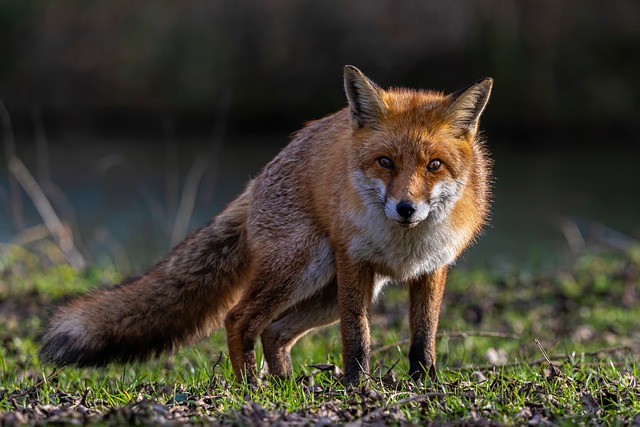The red fox (Vulpes vulpes) is a captivating and highly adaptable mammal that belongs to the Canidae family. Widely distributed across the Northern Hemisphere, this species has earned a reputation for its intelligence, resourcefulness, and attractive appearance. In this article, we will learn in detail about the life, behavior and ecological importance of the red fox.
Physical Characteristics:
The red fox can be easily identified by its reddish fur, white-tipped tail, and distinctive black markings on its ears and legs. However, variations in coat color exist, with some individuals displaying silver, black or cross-phase forms. On average, adult red foxes weigh between 7 to 15 pounds and have a body length of 18 to 35 inches, excluding tail.
Habitat and distribution:
Red foxes are incredibly adaptable and can thrive in a wide variety of environments, from forests and grasslands to urban areas. They are found throughout Europe, Asia, North America, and even parts of North Africa. Their ability to adjust to different habitats has contributed to their wide distribution.
Behavior and Social Structure:
Red foxes are primarily solitary animals, except during the breeding season when they form monogamous pairs. They are known for their cunning and agility, qualities that help them hunt small mammals, birds, insects, and even forage for food. Red foxes are crepuscular, meaning they are most active during dawn and dusk.
Communication among red foxes involves a variety of vocalizations, including barking, howling, and howling, which serve various purposes such as warning of danger, asserting dominance, or attracting mates.
Reproduction:
The breeding season of red foxes usually occurs in winter, with gestation lasting approximately 52 days. A female fox, called a vixen, gives birth to 4 to 6 cubs. Kits are born blind and deaf and remain dependent on their mother's care for several weeks. As they grow, the fox teaches them essential hunting and survival skills. By the end of summer or beginning of autumn, young foxes are ready to leave the den and establish their own territory.
Ecological Role:
Red foxes play an important role in maintaining ecological balance by controlling populations of rodents and small mammals. Their adaptability to different habitats allows them to thrive in both natural and human-altered landscapes. Despite being skilled hunters, red foxes are also opportunistic scavengers, consuming the carcasses and leftovers of larger predators.
Conservation status:
The red fox is not currently considered a threatened species, and its population remains stable. However, localized declines may occur due to habitat loss, diseases, and human-wildlife conflicts. Conservation efforts focus on preserving their natural habitats and reducing conflicts between red foxes and human activities.
The red fox, with its striking appearance and remarkable adaptability, stands as a testament to the resilience of wildlife in the face of changing environments. As we continue to co-exist with these fascinating creatures, it is important to appreciate their ecological importance and work towards ensuring their conservation for future generations.
Here are some interesting facts about red foxes:
- Adaptability: Red foxes are highly adaptable and can thrive in a wide variety of environments, including forests, grasslands, mountains, and urban areas. Their ability to adjust to different habitats has contributed to their wide distribution.
- Physical Appearance: While the classic image of the red fox is a reddish-red coat with a white-tipped tail, variations in coat color exist. Some individuals may have silver, black or cross-phase forms. The black marks on their ears and legs are distinctive features.
- Range and Distribution: Red foxes are found throughout the Northern Hemisphere, including Europe, Asia, North America, and parts of North Africa. Their distribution is wide, and they are one of the most widely distributed carnivorans in the world.
- Nocturnal behavior: Red foxes are crepuscular, meaning they are most active during dawn and dusk. This behavior helps them avoid larger predators that are active at other times of the day.
- Dietary habits: Red foxes are omnivores with a varied diet. They primarily hunt small mammals, birds, and insects, but they are also opportunistic scavengers, eating meat and foraging for fruits and berries.
- Vocalizations: Red foxes are known for their diverse vocalizations, including barking, howling, and howling. These vocalizations serve a variety of purposes, such as communication with mates, warning of danger, and asserting dominance.
- Family Structure: Red foxes are usually solitary animals, but during the breeding season, they form monogamous pairs. The male, called a dog, and the female, called a fox, work together to raise their offspring.
- Reproduction: The breeding season usually occurs in winter, with gestation lasting about 52 days. A female fox gives birth to 4 to 6 cubs, which are blind and deaf at birth. The fox cares for the kits until they are old enough to leave the den.
- Scent marking: Red foxes use scent marking as a method of communication. They have scent glands on their feet, and they use urine to mark their territories. This helps them establish dominance and avoid conflicts with other foxes.
- Lifespan: In the wild, the lifespan of red foxes is typically 3 to 4 years. However, they can live longer in captivity, with some individuals reaching up to 14 years of age.



Comments
Post a Comment